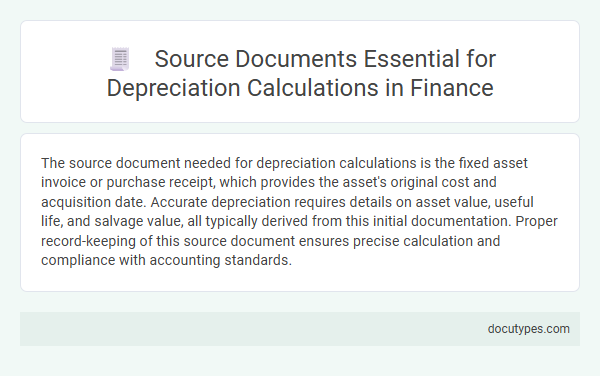The source document needed for depreciation calculations is the fixed asset invoice or purchase receipt, which provides the asset's original cost and acquisition date. Accurate depreciation requires details on asset value, useful life, and salvage value, all typically derived from this initial documentation. Proper record-keeping of this source document ensures precise calculation and compliance with accounting standards.
Introduction to Depreciation and Source Documents
Depreciation is a key accounting method used to allocate the cost of tangible assets over their useful lives. Understanding the source documents required for depreciation calculations ensures accurate financial reporting and compliance.
Source documents provide essential data needed to calculate depreciation accurately, reflecting asset purchase details and related expenditures.
- Purchase Invoice - This document records the original cost and acquisition date of the asset, which are critical for starting depreciation calculations.
- Asset Register - An asset register lists all company assets with specific details such as purchase date, cost, and estimated useful life.
- Maintenance and Repair Records - These documents track additional costs that can affect the asset's book value and depreciation schedule.
Importance of Accurate Documentation in Depreciation
Accurate source documents are essential for precise depreciation calculations, ensuring compliance with accounting standards and tax regulations. Common source documents include purchase invoices, asset registers, and maintenance records, which provide verified details on asset cost and useful life. Proper documentation supports transparent financial reporting and helps prevent errors in asset valuation over time.
Purchase Invoices: Foundation of Asset Records
What is the source document needed for depreciation calculations? Purchase invoices serve as the foundation of asset records in financial management. Your accurate depreciation calculations depend on these documents to verify the initial cost and acquisition date of assets.
Asset Registration and Tagging Documents
Depreciation calculations require precise source documents to ensure asset values are accurately recorded over time. Asset registration and tagging documents serve as essential evidence for identifying and valuing fixed assets.
Asset registration documents provide detailed information such as purchase date, cost, and asset description, which form the basis for calculating depreciation. Tagging documents confirm physical asset identification through assigned asset tags or barcodes, ensuring consistency between records and actual items. These documents together support reliable tracking and amortization schedules in financial reporting.
Supplier Contracts and Warranty Papers
Source documents for depreciation calculations are essential for accurately determining asset value and useful life. Supplier contracts and warranty papers provide key details supporting these assessments.
- Supplier Contracts - These documents specify purchase prices and delivery dates, crucial for establishing the asset's initial cost and depreciation start date.
- Warranty Papers - Warranty information helps define the expected useful life and maintenance obligations, influencing depreciation schedules.
- Depreciation Accuracy - Combining supplier contracts with warranty details ensures your depreciation calculations reflect realistic asset usage and value reduction.
Delivery Receipts and Installation Records
Source documents are essential for accurate depreciation calculations as they provide the initial cost and acquisition date of assets. Delivery receipts and installation records serve as primary evidence confirming the asset's purchase and readiness for use.
Delivery receipts detail the transfer of ownership and asset cost, supporting the start of depreciation schedules. Installation records verify when the asset became operational, ensuring depreciation begins at the correct point in time.
Asset Valuation and Appraisal Reports
Source documents for depreciation calculations play a crucial role in accurately determining asset value over time. Asset valuation and appraisal reports serve as the foundation for these calculations, ensuring compliance and financial accuracy.
- Asset Valuation Reports - Provide the initial purchase cost and fair market value necessary for calculating depreciation.
- Appraisal Reports - Offer expert assessments on the current worth of an asset, essential for adjusting depreciation schedules.
- Purchase Invoices and Contracts - Confirm the acquisition cost and date, which are critical components for applying depreciation methods.
Accurate source documents ensure depreciation reflects true asset value, impacting financial statements and tax calculations.
Capitalization Policy Documentation
Capitalization policy documentation is the primary source document needed for depreciation calculations. It outlines the criteria for classifying assets as capital expenditures, ensuring consistent asset recognition. Accurate depreciation relies on these policies to determine asset cost, useful life, and depreciation method.
Asset Disposal and Sale Records
Source documents for depreciation calculations primarily include asset disposal and sale records. These records provide essential information on the asset's end-of-life value and disposal date.
Asset disposal records detail the sale price, date of sale, and any gain or loss incurred, which are critical for accurate depreciation adjustment. Maintaining precise disposal documentation ensures compliance with accounting standards and accurate financial reporting.
What Is the Source Document Needed for Depreciation Calculations? Infographic

